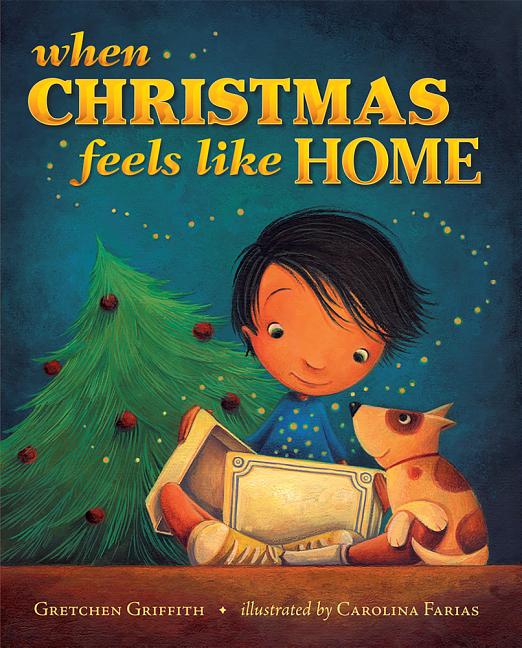
Book Resume
for When Christmas Feels Like Home by Gretchen Griffith and Carolina Farías
Professional book information and credentials for When Christmas Feels Like Home.
See full Book Resume
on TeachingBooks
For young Eduardo, the move from his unnamed Latin American homeland to the United ...read more
- School Library Journal:
- Grades 1 - 3
- Publisher's Weekly:
- Ages 4 - 7
- Kirkus:
- Ages 4 - 8
- TeachingBooks:*
- Grades PK-4
- Word Count:
- 1,097
- Lexile Level:
- 540L
- ATOS Reading Level:
- 3.1
- Cultural Experience:
- Immigrant / Refugee
- Latino (US / Canada)
- Genre:
- Holiday
- Picture Book
- Year Published:
- 2013
9 Subject Headings
The following 9 subject headings were determined by the U.S. Library of Congress and the Book Industry Study Group (BISAC) to reveal themes from the content of this book (When Christmas Feels Like Home).
- Mexican Americans--Fiction
- Expectation (Psychology)--Fiction
- Juvenile Fiction | People & Places | United States - Hispanic & Latino
- Moving, Household--Fiction
- Juvenile Fiction | Holidays & Celebrations | Christmas & Advent
- Immigrants--Fiction
- Juvenile Fiction | Family | General (see also headings under Social Themes)
- North Carolina--Fiction
- Juvenile Fiction | Social Themes | Emigration & Immigration
6 Full Professional Reviews
The following unabridged reviews are made available under license from their respective rights holders and publishers. Reviews may be used for educational purposes consistent with the fair use doctrine in your jurisdiction, and may not be reproduced or repurposed without permission from the rights holders.
Note: This section may include reviews for related titles (e.g., same author, series, or related edition).
From Cooperative Children's Book Center (CCBC)
For young Eduardo, the move from his unnamed Latin American homeland to the United States is a transition made easier by a few familiar things, most notably the Nativity set he carved with his grandfather. Yet his new house still doesn't feel like home. His mother says it will when they put up the Nativity at Christmas. Tío Miguel acknowledges that it will take time: First the mountain "will turn the color of the sun," then "the pumpkins will smile." Tía Sofia adds that his new school will feel familiar "when your words float like clouds from your mouth." But all these things are impossible! Yet one by one, as Eduardo adjusts and makes friends, these and other impossible things happen: Trees change color then turn bare as skeletons; Halloween brings carved, smiling pumpkins; with the first cold weather he can see his breath. Child-friendly details mark the passage of time as a boy adjusts to a new home-and new seasons-in an upbeat look at the immigrant experience that still captures a sense of longing. (Ages 5-8)
CCBC Choices 2014 © Cooperative Children's Book Center, Univ. of Wisconsin - Madison, 2014. Used with permission.
From Horn Book
January 1, 2014
Eduardo moves from a village where the kids play [cf2]fztbol[cf1] to Sleepy Tree Lane, where the kids play football, ride school buses, eat Thanksgiving turkey, and put up Christmas trees. Homesickness aside, Eduardo's immigration experience is conflict-free; but warmly colored, comfortably rounded illustrations ably capture the change of the seasons and the happy anticipation that the wait for Christmas can provide.
(Copyright 2014 by The Horn Book, Incorporated, Boston. All rights reserved.)
From Horn Book
November 1, 2013
Eduardo moves with his family from a village where the kids play ftbol to Sleepy Tree Lane, where the kids play football, ride school buses, carve jack-o'-lanterns, eat Thanksgiving turkey, and put up Christmas trees. Homesickness aside, Eduardo's immigration experience is conflict- (and drama-) free; but warmly colored, comfortably rounded illustrations do a wonderful job with the change of the seasons and the happy anticipation that the wait for Christmas can provide. roger sutton
(Copyright 2013 by The Horn Book, Incorporated, Boston. All rights reserved.)
From School Library Journal
October 1, 2013
Gr 1-3-More an affirmation of patience and fortitude than a Christmas story, this heartwarming tale of one family's immigration experience focuses on Eduardo, a schoolboy uneasy about leaving his small village in Latin America and moving to the U.S. Mami assures him that he will feel more at home by the time they open the box containing the wood-carved Nativity set that Eduardo made with his grandfather. His Tio Miguel tells him about some of the things that will happen between now and then (a mountain will turn the color of the sun, pumpkins will smile, words will "float like clouds from your mouth..."). As months go by, the seemingly impossible predictions come true, and Eduardo really does feel at home when Christmas preparations begin. The text is succinctly descriptive with a bit of Spanish vocabulary sprinkled into the dialogue. Warm, autumnal hues enhance the stylized illustrations, inviting readers to linger on expressive character details. A charming and worthwhile read for any time of year.-Linda Israelson, Los Angeles Public Library
Copyright 2013 School Library Journal, LLC Used with permission.
From Publisher's Weekly
September 16, 2013
In this sensitive story, when a family relocates to an American town from an unnamed Latin American country, Eduardo seeks assurance about when he will feel at home. "First that mountain will turn the color of the sun," says Tío Miguel, adding that "pumpkins will smile" and the trees will resemble skeletons. "No se puede," is Eduardo's response, but as the seasons change and Eduardo makes friends, these and other promises comes to fruition. At Christmas, Eduardo finally feels at home as he arranges the family Nativity set he treasures. Farias's burnished paintings create a feeling of warmth and luminescence in every scene, while Griffith's soothing, poetic language delivers a comforting message about traditions and transitions. Ages 4â€"7. Illustrator's agent: Mela Bolinao, MB Artists.
From Kirkus
September 1, 2013
When a little boy named Eduardo moves from a village in an unnamed Latin American country to a town in the United States, he struggles to feel at home in his new surroundings. Eduardo moves to the U.S. in the fall, bringing along his futbol (soccer ball) and his family's box of Christmas decorations, with a hand-carved Nativity set that Eduardo cherishes. He loves playing futbol, but the boys in his new neighborhood play football with a ball of a different shape. He starts school, but he struggles with English lessons, though he does well in math. Eduardo's parents and aunt and uncle gently encourage him to adjust, and gradually, he makes friends and participates in family celebrations at Halloween and Thanksgiving. On Christmas, Eduardo sets out the family's Nativity set and announces, "This is home." Eduardo's adjustment is perhaps a little too quickly resolved, but the genuine emotions and strong family support are sensitively portrayed. Spanish words and phrases are skillfully woven into the text, with each use defined through the illustrations, context, or by the word or phrase being repeated in English. Farias, an artist from Argentina, provides appealing illustrations with a muted palette matching Eduardo's mood. A gentle, lyrical story that can be read year-round as a sensitive exploration of the meaning of home. (Picture book. 4-8)
COPYRIGHT(2013) Kirkus Reviews, ALL RIGHTS RESERVED.
2 Book Awards & Distinctions
When Christmas Feels Like Home was recognized by committees of professional librarians and educators for the following book awards and distinctions.
Preview Digital Book
Explore When Christmas Feels Like Home on Marketplace. Access requires OverDrive Marketplace login.
This Book Resume for When Christmas Feels Like Home is compiled from TeachingBooks, a library of professional resources about children's and young adult books. This page may be shared for educational purposes and must include copyright information. Reviews are made available under license from their respective rights holders and publishers.
*Grade levels are determined by certified librarians utilizing editorial reviews and additional materials. Relevant age ranges vary depending on the learner, the setting, and the intended purpose of a book.
Retrieved from TeachingBooks on February 02, 2025. © 2001-2025 TeachingBooks.net, LLC. All rights reserved by rights holders.


 CCBC Choices, Selection, 2014
CCBC Choices, Selection, 2014
 Notable Social Studies Trade Books for Young People, 2015-2024, History, Life, Culture in the Americas Selection, 2014
Notable Social Studies Trade Books for Young People, 2015-2024, History, Life, Culture in the Americas Selection, 2014
